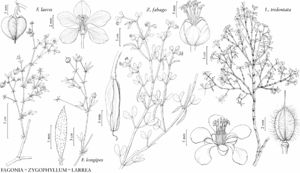Fagonia
Sp. Pl. 1: 386. 1753.
| Taxon | Illustrator ⠉ | |
|---|---|---|
 | Fagonia longipes Fagonia laevis Zygophyllum fabago Larrea tridentata | Barbara Alongi Barbara Alongi Barbara Alongi Barbara Alongi |
Herbs, subshrubs, or shrubs, perennial. Stems erect to spreading or ± prostrate, highly branched, angled or ridged [terete], less than 1 m, becoming woody at least at base, hairy and glandular to almost glabrate [glabrous]. Leaves opposite, palmately compound [rarely scalelike]; stipules persistent, stiff [herbaceous], spinelike, apex spinose or spinulose; petiolules usually present; leaflets (1–) 3 [–7], inserted on petiole apex, distinct, [linear] lanceolate to ovate [obovate], terminal largest, base cuneate, apex spinose, surfaces stipitate-glandular, glabrate, or glabrous [hairy]. Pedicels in leaf-axils, erect, becoming reflexed in fruit. Flowers usually solitary, regular to slightly irregular by twisting of petals; sepals deciduous or persistent, 5, distinct, green to purple, equal, margins undifferentiated or sometimes membranous, apex acute-attenuate, hairy or glandular to glabrate [glabrous]; petals soon deciduous, 5, imbricate, spreading, often twisted (propellerlike), purple to pink [rarely white], ± obovate, base clawed, apex rounded, usually apiculate; nectary rudimentary; stamens 10, ± equal; filaments free, filiform, unappendaged; anthers sagittate; ovary sessile, 5-lobed, 5-locular, hairy and usually glandular; ovules (1–) 2 per locule; style persistent, forming beak on fruit; stigma minute. Fruits capsules, ovoid, deeply 5-lobed, loculicidally dehiscent. Seeds usually 1 per locule, brownish to black, flat, ± ovate, seed-coat mucilaginous when wet.
Habitat: Warm-arid habitats.
Distribution
sw United States, nw Mexico, sw South America, w, s Asia, n, sw Africa, Atlantic Islands (Canary Islands), Atlantic Islands (Cape Verde Islands)
Discussion
Species 35 (3 in the flora).
Although Fagonia species are perennial, they sometimes facultatively form flowers and reproduce during their first season. The seeds of Fagonia are sticky when wet, which probably aids in dispersal (D. M. Porter 1974b).
Although Fagonia laevis and F. pachyacantha do not cluster next to one another in the trees illustrating a phylogenetic study of the genus (B.-A. Beier et al. 2004b), they were placed together in the taxonomic revision (Beier 2005). Beier reported F. californica Bentham from Arizona and California, considering F. laevis and F. longipes to be synonyms; however, F. californica is a species of Baja California Sur and Sonora and does not occur in the flora area (D. M. Porter 1963). Fagonia californica differs from F. longipes in being prostrate-spreading, not erect to spreading; having leaflets that are elliptic to oblong-lanceolate or oblong, not linear to linear-lanceolate; and having pedicels that are stout and 1–6 mm, not slender and 8–20 mm. It differs from F. laevis, which has erect to spreading stems and linear-elliptic leaflets and is mostly glabrous, not densely stipitate-glandular.
Selected References
Lower Taxa
Key
| 1 | Stems densely short-stipitate- or subsessile-glandular, glands golden, to 1 mm diam.; older stems glabrate basally; stipules straight, 3–16 mm, about as long as petioles. | Fagonia pachyacantha |
| 1 | Stems glabrous or densely to sparsely minutely stipitate-glandular, glands clear or yellow, to 0.1 mm diam.; older stems mostly glabrous or becoming glabrate; stipules curved, 1–6 mm, shorter than petioles. | > 2 |
| 2 | Pedicels 8–20 mm; ovaries and capsules puberulent and minutely stipitate-glandular; stems, stipules, petioles, pedicels, and sepals stipitate-glandular; lateral leaflets about same width as terminal leaflet. | Fagonia longipes |
| 2 | Pedicels 1.5–7 mm; ovaries and capsules glabrous, puberulent, or minutely strigose, not glandular; plants generally glabrous, but often pedicels and sepals, sometimes stipules and petioles, and rarely ultimate branches sparsely stipitate-glandular; lateral leaflets often narrower than terminal leaflet. | Fagonia laevis |